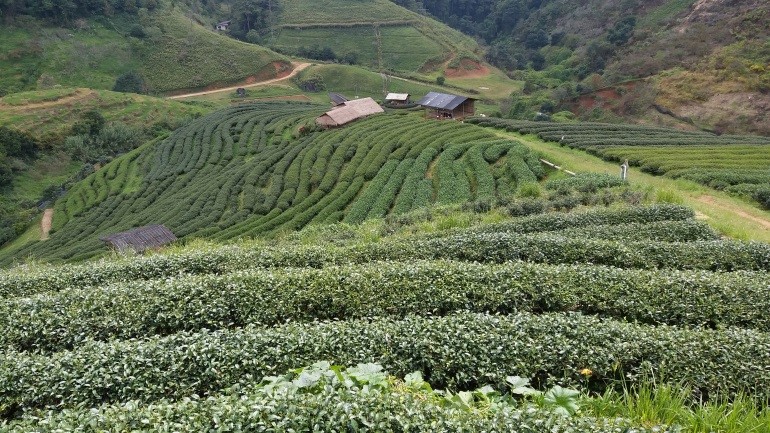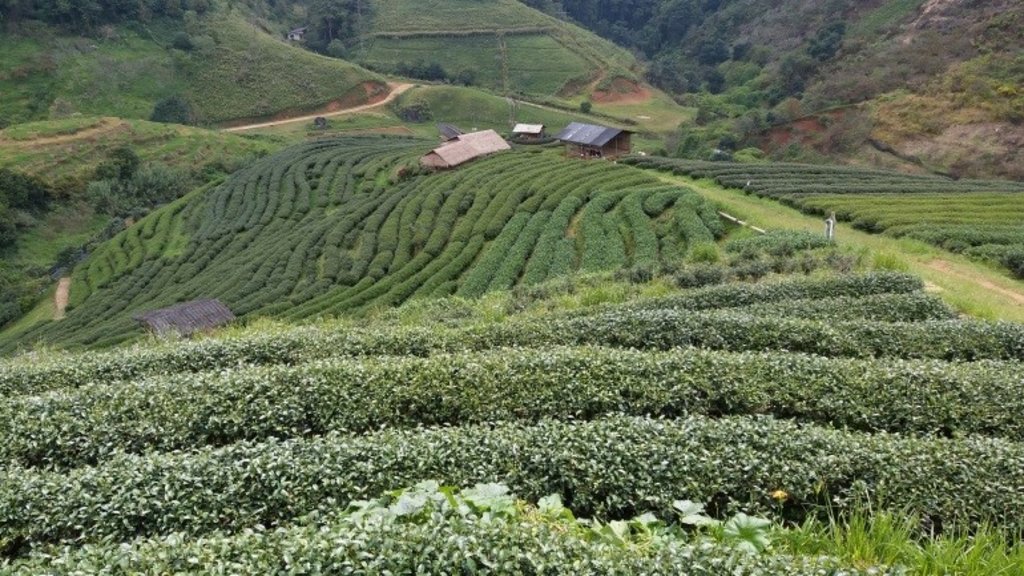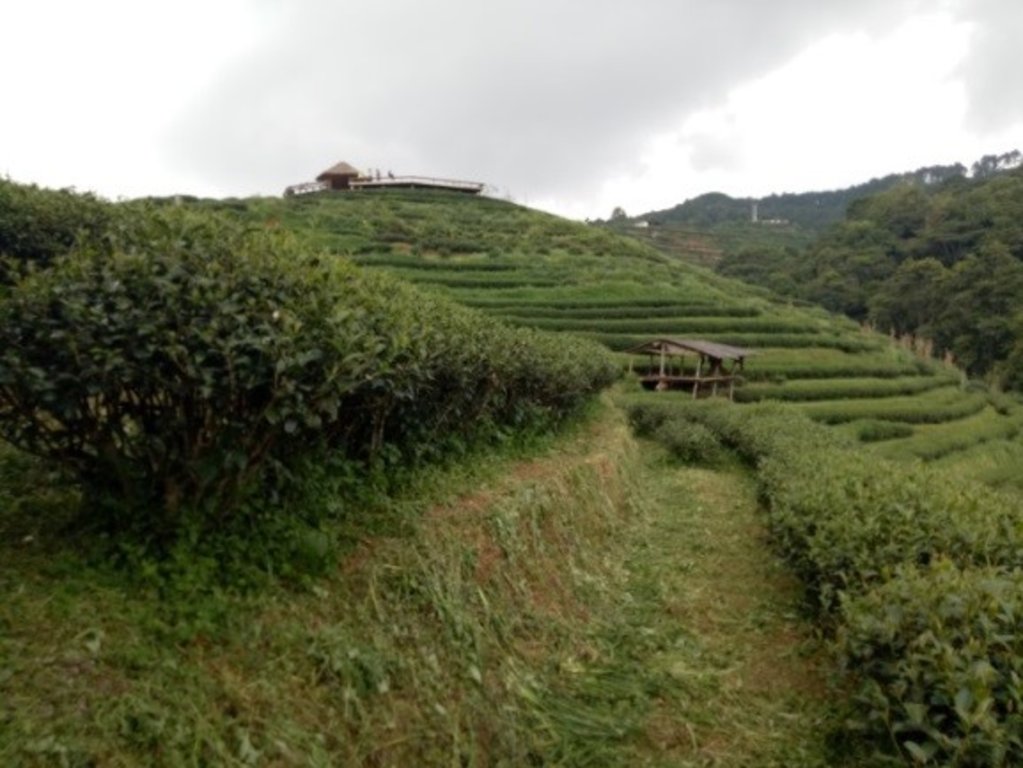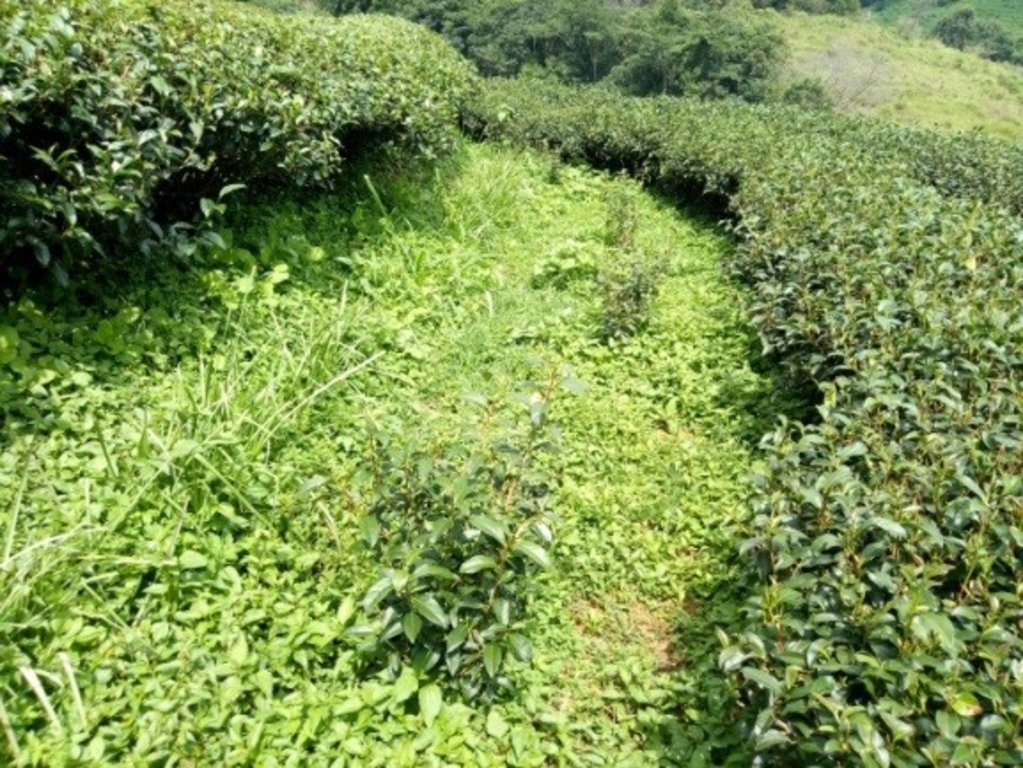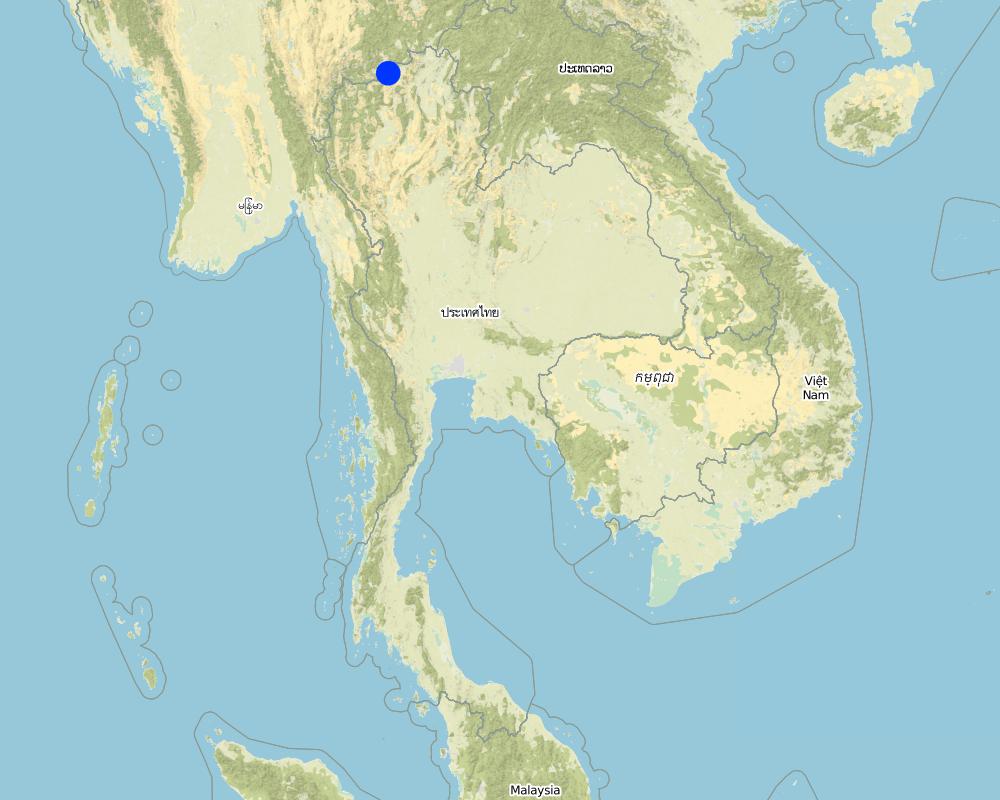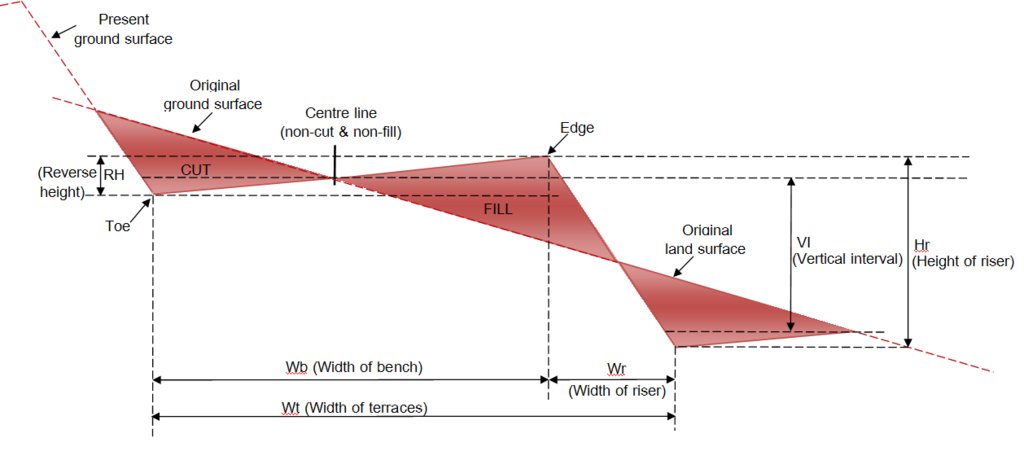Continuous bench terrace in high sloping area for tea plantation [Tailandia]
- Creación:
- Actualización:
- Compilador: Pitayakon Limtong
- Editor: –
- Revisor: Rima Mekdaschi Studer
Continuous bench terrace in high sloping area for tea plantation
technologies_4281 - Tailandia
Visualizar secciones
Expandir todo Colapsar todos1. Información general
1.2 Detalles de contacto de las personas de referencia e instituciones involucradas en la evaluación y la documentación de la Tecnología
Persona(s) de referencia clave
co-compiler:
Tipvong Tanomkwan
Land Development Department
Tailandia
usuario de la tierra:
Mokngoen Jai
Palaung hill tribe farmer
Tailandia
Local officer of Station:
Tapangtong Werapong
Angkhang Royal Agricultural Station
Tailandia
local officer of LDD:
Boonchoo Sontaya
Royal Project Land Development Center, Land Development Department
Tailandia
Nombre de la(s) institución(es) que facilitaron la documentación/ evaluación de la Tecnología (si fuera relevante)
Land Development Department (Land Development Department) - Tailandia1.3 Condiciones referidas al uso de datos documentados mediante WOCAT
El compilador y la/s persona(s) de referencia claves aceptan las condiciones acerca del uso de los datos documentados mediante WOCAT:
Sí
1.4 Declaración de la sostenibilidad de la Tecnología descrita
¿La Tecnología aquí descrita resulta problemática en relación a la degradación de la tierra, de tal forma que no puede considerársela una tecnología sostenible para el manejo de la tierra?
No
Comentarios:
This continuous bench terrace with 3 meters base in slopping highland constructed at Plot 2000 for Chinese tea plantation. Such conservation measure can decrease soil erosion and runoff, and this slopping area can use for agriculture and increase land users products and income.
2. Descripción de la Tecnología MST
2.1 Breve descripción de la Tecnología
Definición de la Tecnología:
Utilization of continuous bench terrace (3 meters based) as sustainable soil and water conservation measure for tea plantation in slopping area of the northern Thailand
2.2 Descripción detallada de la Tecnología
Descripción:
The continuous bench terrace (forward-sloping terrace) as soil and water conservation measure in the high landscape at Angkhang Royal Agricultural Station, Moo 5, Mae Ngon subdistrict, Fang district, Chiang Mai province was constructed in 1999 in the area of former winter fruit plantation plot of the station. Land Development Department had surveyed, designed and constructed the 3 meters wide of continuous bench terrace, which it is suitable for the tea cultivation and total area is approximately 100 rai. The Angkhang Royal Agricultural Station had selected 50 households of Palaung hill tribe who have more ability and aptitude to grow Chinese tea to participate in the Chinese tea development and promotion project in 2000 and named this area as "Plot 2000". The overview of this area is complex mountainous terrain with slope range 16-30 percent, and average attitude is 1,400 meters above sea level. The soil texture is silty loam and very deep (more tan 1.2 meter), almost well drained soil. The soil organic matter is moderate around 1-3 percent. Moreover, the data of Doi Ang Khang Meteorological Station (Station Code 48302) is located at average attitude 1,529 meters above the sea level, and average temperature throughout the year is 22.9 Celsius with the highest temperature is 32.1 Celsius (during May) and the lowest temperature is 3.9 Celsius (during December), and average annual rainfall is 1,925.3 mm, with rain starting from April to October.
In the past, the watershed areas in northern Thailand have been disturbed by natural disasters, climate change, and human threats. The hill tribe people had invaded the forest to grow opium and shifting cultivation continuously. These condition caused the serious problem in soil erosion, runoff with soil surface, lose of topsoil and plant nutrients, decreasing in soil fertility and productivity with the extremely damage to upstream forest ecosystem. Until in the year 1969, Angkhang Royal Agricultural Station was established from the initiative of His Majesty King Rama 9, which aimed to conduct research on the planting of winter economic crops as an example for hill tribe to plant those crops as their career instead of opium cultivation, and also stop cutting and shifting cultivation. Nowadays there are more than 50 species of economic plants in this project and generating more income for land users, more than that this slopping area is the sustainable in land use and land management under organization of the Royal Project Foundation.
The benefits this technology is important in sustainable utilization of land resources in this area, and all land users around the Angkhang Royal Agricultural Station have stable and more income because they can grow Chinese tea and also other winter economic crops on this highland throughout the year. Moreover, this continuous bench terrace is more convenient for land users in fertilizer application, soil improvement, machines operation, tea harvesting and also yield transportation from cultivated plots to local processing factory.
The impact of implementation continuous bench terrace with 3 meters based:
1. The obvious economic and social impacts of land users are the stability of income from the production of Chinese tea, which are produced throughout the year. This conservation is more convenient for land users to implement in their plot and also transport from cultivated plots to local processing factory. The local officers from Angkhang Royal Agricultural Station and others government agencies closely advised and guided breeding, planting, soil management, harvesting and price guarantee.
2. The environmental and ecological impact is to reduce the amount of runoff and soil sediment, increase soil moisture, preserve soil nutrients and fertility, encourage biodiversity in the area of Plot 2000.
3. The society and culture impact is all ethnic groups are given the opportunity to receive the allocation of arable land according to the group of plants that they are comfortable and want to produce. Thus respecting the use of land in zoning as allocated from the station, including right to use water. These caused the strength of community institutions, where they have various crop production groups, organic fertilizer production Group and others. They are all member of the cooperative of the community.
2.3 Fotografías de la Tecnología
Comentarios generales sobre las fotos:
Soil and water conservation measure (3-meter base) as continuous bench terrace with Chinese tea cultivation on highland (at Plot 2000). The winter fruit trees in this area of AngKhang Royal Agricultural Station has been changed to the bench terrace for Chinese tea plantation with good agricultural practices (GAP) more than 19 years, which shows the appropriate land use conditions in sustainable soil and water conservation.
2.4 Videos de la Tecnología
Fecha:
14/10/2018
Lugar:
Ban Thap Sub-District, Mae Chaem District, Chiang Mai Province, 50270
Nombre del videógrafo:
Ms. Somjit Lertdisayawan / Ms. Tanomkwan Tipvong
2.5 País/ región/ lugares donde la Tecnología fue aplicada y que se hallan comprendidos por esta evaluación
País:
Tailandia
Región/ Estado/ Provincia:
Ban Thap Sub-District, Mae Chaem District, Chiang Mai Province, 50270
Especifique más el lugar :
Extension area for Chinese tea plantation (Plot 2000) at Angkhang Royal Agricultural Station, Mae Ngon Subdistrict, Fang District, Chiang Mai ProvincePlot
Especifique la difusión de la Tecnología:
- distribuida parejamente sobre un área
Si se desconoce el área precisa, indique el área aproximada cubierta:
- 0.1-1 km2
Comentarios:
Angkhang Royal Agricultural Station is an area for research and development for the winter crops and trees around 1,811 rai, with high from the sea level 1,400 meters. There are hill tribe villages around the station and the total population is about 3,215 people. The weather is cool all year round with the average temperature is 17.7 degrees, the maximum temperature is 32 degrees in April. And the minimum temperature of -3 degrees in January. The average rainfall is 2,075 mm per year and slope area 20-35%.
Map
×2.6 Fecha de la implementación
Indique año de implementación:
1999
Si no se conoce el año preciso, indique la fecha aproximada:
- 10-50 años atrás
2.7 Introducción de la Tecnología
Especifique cómo se introdujo la Tecnología:
- mediante proyectos/ intervenciones externas
Comentarios (tipo de proyecto, etc.):
The Royal Project implement in the upstream forest area and emphasize to promote and encourage career of hilltribe land users around AngKhang Agricultural Station. Moreover, the continuous bench terrace is introduced in this high slope area to prevent and conserve soil and water resources, reduce soil erosion and runoff.
3. Clasificación de la Tecnología MST
3.1 Propósito(s) principal(es) de la Tecnología MST
- mejorar la producción
- reducir, prevenir, restaurar la degradación del suelo
- conservar el ecosistema
- preservar/ mejorar biodiversidad
- crear impacto económico benéfico
3.2 Tipo(s) actuales de uso de la tierra donde se aplica la Tecnología

Tierras cultivadas
- Cultivos perennes (no leñosos)
- Tea
Número de temporadas de cultivo por año:
- 1
Especifique:
Chinese tea, Camellia sinensis var. sinensis in 15.43 sq.km. or 96.4375 Rai.
Comentarios:
Palaung hill tribe will plant Chinese tea on this area in late rainy season, about August to October because after planting root of tea would grow well in the cool condition and do not face problems like during the rainy season. The trimming will be about 10-12 months before planting. spacing between row is 1.2 meter and between tree is 60 centimeters. There are about 2,200 trees per Rai.
3.3 ¿Cambió el uso de tierras debido a la implementación de la Tecnología?
Comentarios:
-
3.4 Provisión de agua
Provisión de agua para la tierra donde se aplica la Tecnología:
- mixta de secano – irrigada
Comentarios:
The land use in this area is Chinese tea in Plot 2000, with 2 species, namely soft stalks and variety no.12, This area is mainly rain fed together with spraying system. And water supply system is in the upper part of the area and distribute to tea plot by PVC pipe and set springier cover over this plot. however, this water system is high cost but it is worthwhile.
3.5 Grupo MST al que pertenece la Tecnología
- medida de pendiente transversal
- reducción de riesgos de desastres basados en el ecosistema
3.6 Medidas MST que componen la Tecnología

medidas vegetativas
- V2: Pastos y plantas herbáceas perennes

medidas estructurales
- S1: Terrazas
Comentarios:
The continuous bench terrace technology is suitable soil and water conservation in slopping area,where is the upper part of watershed in the National Reserved Forest area. This technology need knowledge and expertise in construction of conservation measure with high investment and more maintenance. That means government and private sector should support in construction and land users should maintain of bench terrace and take care in soil fertility.
3.7 Principales tipos de degradación del suelo encarados con la Tecnología

erosión de suelos por agua
- Wt: pérdida de capa arable/ erosión de la superficie
Comentarios:
Soil resources in this area is degraded by deforestation and climate changes, where it is risk in runoff and soil erosion. In this case plant nutrients in soil surface and sediment is removed to the low part, soil fertility is decreased, and ecosystem in upstream forest is degraded.
3.8 Prevención, reducción o restauración de la degradación del suelo
Especifique la meta de la Tecnología con relación a la degradación de la tierra:
- prevenir la degradación del suelo
- reducir la degradación del suelo
Comentarios:
In 1999, the Angkhang Royal Agricultural Station cooperated with Land Development Department construct the continuous bench terrace and soil improvement in this steep slope area to prevent soil erosion and runoff. Moreover, the Royal Irrigation Department support water supply system and the Provincial Electricity Authority support electricity services.
4. Especificaciones técnicas, actividades de implementación, insumos y costos
4.1 Dibujo técnico de la Tecnología
Especificaciones técnicas (relacionadas al dibujo técnico):
Operation in tea plantation in Plot 2000:
1. During 1999-2000, Angkhang Royal Agricultural Station, in collaboration with Land Development Department, conducted a survey to select the highland mountainous area with slope 20-35 percent, where land is deteriorated conditions, risk of erosion and landslides, low fertility. In order to design and construct soil and water conservation measure as continuous bench terrace with 3 meters based for Chinese tea plantations as a plot to demonstrate and promote the conservation measure on such area for Palaung hill tribe. Soil in this area is Mae Taeng soil series where it is very deep soil, with texture is sandy loam to sandy loamy, dark brown in color and soil reaction is slightly acidic (pH 5.5-6.5). In lower layer of soil profile is clay, dark red to red and soil reaction is very acidic to acidic (pH 4.5-5.5)
2. Set up the digging contour line by using wood pole from the highest point of the area to the lowest point and used the upper line is the first line of the terrace. Then dig the next contour line down along the slope and distance between the contour line is equal to distance of each terrace that is 3 meters. After that dig the terrace as 3 meters based on the contour line and set the level of terrace inclined around 1-2 degrees to drain water from this area.
3. The operation of cut and fill of soil along the contour line and move the surface soil and reshape the surface soil in this area. And dig the soil by using manpower or machine from the lower edge of the plot to make the terrace in the upper part. Therefore move, adjust and compact the soil in this area and reshape surface of soil and make terrace with 3.0 meters width and incline about 1-2 degrees, and make additional 10 percent of soil thickness to prevent the collapse, and keep the soil organic matter on the upper part of the floor and height of each terrace should not more than 1.8 meters, therefore cutting the soil down to 0.9 meters and filling the soil 0.9 meters.
4. Vetiver grass plantation conserved 2 rows of terrace by planting over the top of the terrace and planting another 1 row over the filled soil and planting spacing is 10 centimeters.
5.1 After bench terrace construction is completed in 2000, where Angkhang Royal Agricultural Station selected land users and allocated land for tea plantation for 50 households of Palaung hill tribe to set experiment of 2 varieties of Chinese tea as soft stem and breed number 12 varieties.
5.2 Land users usually planted Chinese tea at late of rainy season, which is about August to October as suitable planting season. Because after planting in this period, the root of the tea will affect the cold condition that make they grow well and do not face problems like during the rainy season
5.3 The planting period of the cutting stalk will be about 10-12 months before planting. The planting spacing is 1.2 meters in length. The spacing between stalk is 60 centimeters, and spaced about 40-45 centimeters in a row. There are approximately 2,200 trees per rai.
6. Maintenance of Plot 2000
6.1 Fertilizer application focuses on using compost from animal manure produced by this group. By digging a long groove at the end of the canopy of tea about 15 cm deep on both sides. Compost is applied 2 kilograms per tree a year, and apply 3 times during February, June, October and also use bio-extracted solution spray to tea tree for stretching the shoot with dark green leaf, plump, good weight.
6.2 Irrigation in this area use both from rain and water storage tank in the upper area and distribute directly to the plot by PVC pipe.
6.3 Almost land users in this area harvested their organic tea from April to December and will donant during January-March. At present, the no.12 variety has average yield 800 kilograms per rai, they can harvest 5-6 times a year, while the soft stem variety has average yield 600 kilograms per rai, and can harvest 4-5 times a year. In this case they would have total annual yield 60,000 kilograms and annual average income is 100,000-300,000 baht per household.
7. Maintenance of bench terrace in case of damage by runoff, all land users will repair their terrace by themselves in the dry season. In the serious case of erosion, Land Development Department will support such maintenance at rate of 500 baht per rai.
Autor:
Ms. Tanomkwan Tipvong
4.2 Información general sobre el cálculo de insumos y costos
Especifique cómo se calcularon los costos e insumos:
- por área de Tecnología
Indique tamaño y unidad de área:
The area of continuous bench terrace 3 meter board
Si usa una unidad de área local, indique el factor de conversión a una hectárea (ej. 1 ha = 2.47 acres): 1 ha =:
15.43
otra / moneda nacional (especifique):
Baht
Si fuera relevante, indique la tasa de cambio de dólares americanos a la moneda local (ej. 1 U$ = 79.9 Reales Brasileros): 1 U$ =:
15448,6
Indique el costo promedio del salario de trabajo contratado por día:
175.82
4.3 Actividades de establecimiento
| Actividad | Momento (estación) | |
|---|---|---|
| 1. | Survey, select the area and design conservation measure | the first year (1998) |
| 2. | set up contour line for terrace | the first year (1998) |
| 3. | construct bench terrace | before of rainy season 1999 |
| 4. | Vetiver grass plantation on the terrace | early of rainy season 1999 |
| 5. | Chinese tea plantation | in rainy season, Aug-Oct 2000 |
| 6. | Fertilizer application 3 times | Feb, Jun and Oct |
| 7. | Water application | throughout the planting period |
| 8. | Fertilizer application | throughout the planting period |
| 9. | Harvest | harvesting period |
| 10. | Maintenance bench terrace | in dry season, April |
Comentarios:
-
4.4 Costos e insumos necesarios para el establecimiento
| Especifique insumo | Unidad | Cantidad | Costos por unidad | Costos totales por insumo | % de los costos cubiertos por los usuarios de las tierras | |
|---|---|---|---|---|---|---|
| Mano de obra | site survey 1 day | man | 0,5 | 175,82 | 87,91 | |
| Mano de obra | set up contour line 1 day | man | 4,0 | 175,82 | 703,28 | |
| Mano de obra | vetiver planting (400 slips x 8 rows) | slip | 3200,0 | 1,65 | 5280,0 | |
| Mano de obra | man power (2.4 cu.m./m.) | cu.m. | 88,0 | 100,88 | 8877,44 | |
| Equipo | machine power (2.4 cu.m./m.) | cu.m. | ||||
| Equipo | pin wood | unit | 100,0 | 5,0 | 500,0 | |
| Material para plantas | vetiver slip (LDD supported) | None | 3200,0 | |||
| Costos totales para establecer la Tecnología | 15448,63 | |||||
| Costos totales para establecer la Tecnología en USD | 1,0 | |||||
Si el usuario de la tierra no cubrió el 100% de los costos, indique quién financió el resto del costo:
Land Development Department by Center of land development for Royal Project supported the budget by conduct the bench terrace in this area.
Comentarios:
-
4.5 Actividades de establecimiento/ recurrentes
| Actividad | Momento/ frequencia | |
|---|---|---|
| 1. | maintain and repair bench terrace | in dry season 3-5 years/time |
Comentarios:
In the case of bench terrace are not so much damaged, and size of rill is around 5-20 cm. wide and not very deep. Most of the land users usually repair that terrace by themselves during the dry season.
4.6 Costos e insumos necesarios para actividades de mantenimiento/ recurrentes (por año)
| Especifique insumo | Unidad | Cantidad | Costos por unidad | Costos totales por insumo | % de los costos cubiertos por los usuarios de las tierras | |
|---|---|---|---|---|---|---|
| Mano de obra | man power to repair the terrace | man | 1,0 | 500,0 | 500,0 | 100,0 |
| Indique los costos totales para mantenecer la Tecnología | 500,0 | |||||
| Costos totales para mantener la Tecnología en USD | 0,03 | |||||
Si el usuario de la tierra no cubrió el 100% de los costos, indique quién financió el resto del costo:
All maintenance cost of bench terrace are supported by Center of Land Development for Royal Project, Land Development Department.
Comentarios:
Center of Land Development for Royal Project, Land Development Department directly cooperated with the Royal Project.
4.7 Factores más determinantes que afectan los costos:
Describa los factores más determinantes que afectan los costos:
construction of continuous bench terrace and maintenance cost, which it is all invested by government sector, Land Development Department.
5. Entorno natural y humano
5.1 Clima
Lluvia anual
- < 250 mm
- 251-500 mm
- 501-750 mm
- 751-1,000 mm
- 1,001-1,500 mm
- 1,501-2,000 mm
- 2,001-3,000 mm
- 3,001-4,000 mm
- > 4,000 mm
Especifique el promedio anual de lluvia (si lo conoce), en mm:
1925,30
Especificaciones/ comentarios sobre la cantidad de lluvia:
The number of rainy day is 160.9 days per year. The day with the highest daily rain (daily max.) average 149.4 mm/day in October. The number of day has storm average of 57.5 days and highest per year in May is 10.5 days
Indique el nombre de la estación metereológica de referencia considerada:
Doi Angkang (Index station 48302), 19° 55' 53.0" N and 99° 2' 54.0" E, at attitude MSL 1529 m. (2006-2015)
Zona agroclimática
- Sub-húmeda
According to data from climatic station 48302 , it is found that the duration of the precipitation period is more than half of the evaporation potential (PET) between May-October or about 6 months (180 days).
5.2 Topografía
Pendientes en promedio:
- plana (0-2 %)
- ligera (3-5%)
- moderada (6-10%)
- ondulada (11-15%)
- accidentada (16-30%)
- empinada (31-60%)
- muy empinada (>60%)
Formaciones telúricas:
- meseta/ planicies
- cordilleras
- laderas montañosas
- laderas de cerro
- pies de monte
- fondo del valle
Zona altitudinal:
- 0-100 m s.n.m.
- 101-500 m s.n.m.
- 501-1,000 m s.n.m
- 1,001-1,500 m s.n.m
- 1,501-2,000 m s.n.m
- 2,001-2,500 m s.n.m
- 2,501-3,000 m s.n.m
- 3,001-4,000 m s.n.m
- > 4,000 m s.n.m
Indique si la Tecnología se aplica específicamente en:
- no relevante
Comentarios y especificaciones adicionales sobre topografía :
This technology is used in slope 20-35% , slope complex and slope more than 35%.
5.3 Suelos
Profundidad promedio del suelo:
- muy superficial (0-20 cm)
- superficial (21-50 cm)
- moderadamente profunda (51-80 cm)
- profunda (81-120 cm)
- muy profunda (>120 cm)
Textura del suelo (capa arable):
- mediana (limosa)
Textura del suelo (> 20 cm debajo de la superficie):
- fina/ pesada (arcilla)
Materia orgánica de capa arable:
- media (1-3%)
Si se halla disponible, adjunte una descripción completa de los suelos o especifique la información disponible, por ej., tipo de suelo, pH/ acidez de suelo, capacidad de intercambio catiónico, nitrógeno, salinidad, etc. :
Angkhang Royal Agricultural Station is directly respond covered 16,577 rai, with 5 main villages, namely Ban Nala, Ban Rim, Ban Pang Ma, Ban Khum, and Ban Luang. Total population is 3,929 people. The overall landscape is slope complex in mountain range surrounded by a pan-shaped basin. This agricultural area is promoted the hill tribe community to grow winter crops. The general condition of this area is pine forest and evergreen forest. The attitude is 1,400 meters above the sea level. Most of soil series are Ban Luang Series. Soil loamy soil. Angkhang Series is a soil formed by limestone, rock, shell, shale. The overall soil condition is good structure, but almost highland with high slope and acidic condition (pH 4.5-6.0).
5.4 Disponibilidad y calidad de agua
Agua subterránea:
> 50 m
Disponibilidad de aguas superficiales:
bueno
Calidad de agua (sin tratar):
solo para uso agrícola (irrigación)
¿La salinidad del agua es un problema?
No
¿Se está llevando a cabo la inundación del área? :
No
Comentarios y especificaciones adicionales sobre calidad y cantidad de agua:
In the past, there was no soil and water conservation measure, where soil erosion and severe runoff is occurred when it has heavy rain, especially during the rainy season. Soil surface was transported to the lower part, where organic matter and plant nutrients lost from this area and small rill and deep groove is formed in the upper part. Moreover such soil sediment in runoff accumulated in the channel and natural reservoir.
5.5 Biodiversidad
Diversidad de especies:
- elevada
Diversidad de hábitats:
- mediana
Comentarios y especificaciones adicionales sobre biodiversidad:
In Plot 2000 can observe several insects in both of predators and parasitic insects such as dragonflies, beetles, turtles, striped mungs, ants, also earthworm and others.
5.6 Las características de los usuarios de la tierra que aplican la Tecnología
Sedentario o nómada:
- Sedentario
Orientación del mercado del sistema de producción:
- mixta (subsistencia/ comercial)
Ingresos no agrarios:
- menos del 10% de todos los ingresos
Nivel relativo de riqueza:
- promedio
Individuos o grupos:
- grupos/ comunal
Nivel de mecanización:
- trabajo manual
Género:
- mujeres
- hombres
Edad de los usuarios de la tierra:
- jóvenes
- personas de mediana edad
- ancianos
Indique otras características relevantes de los usuarios de las tierras:
All land users and their family members worked in their land such as tea leaves harvest, weed control, fertilizer application, tea planting, trimming and others, which they would not prefer to hire workers.
5.7 Área promedio de la tierra usada por usuarios de tierra que aplican la Tecnología
- < 0.5 ha
- 0.5-1 ha
- 1-2 ha
- 2-5 ha
- 5-15 ha
- 15-50 ha
- 50-100 ha
- 100-500 ha
- 500-1,000 ha
- 1,000-10,000 ha
- > 10,000 ha
¿Esto se considera de pequeña, mediana o gran escala (refiriéndose al contexto local)?
- pequeña escala
Comentarios:
The leader of Plot 2000 (Mr. Chai) has land for tea plantation 4 rai. and also Jiaogulan herb plantion 1 rai, and rental land for agriculture 1 rai.
5.8 Tenencia de tierra, uso de tierra y derechos de uso de agua
Tenencia de tierra:
- individual, sin título
Derechos de uso de tierra:
- comunitarios (organizado)
Derechos de uso de agua:
- comunitarios (organizado)
Especifique:
-
Comentarios:
All land users in this area would not right in land ownership but they have right to use these land for agricultural purposes. And Angkhang Royal Agricultural Station separated and allocated these land for selected land users and also land zoning for fruit trees, Vegetables, flowers and ornamental plants and others.
5.9 Acceso a servicios e infraestructura
salud:
- pobre
- moderado
- bueno
educación:
- pobre
- moderado
- bueno
asistencia técnica:
- pobre
- moderado
- bueno
empleo (ej. fuera de la granja):
- pobre
- moderado
- bueno
mercados:
- pobre
- moderado
- bueno
energía:
- pobre
- moderado
- bueno
caminos y transporte:
- pobre
- moderado
- bueno
agua potable y saneamiento:
- pobre
- moderado
- bueno
servicios financieros:
- pobre
- moderado
- bueno
Comentarios:
They have cooperative activity to support investment and production costs such as fertilizers, bio-pesticides, pesticides and others.
6. Impactos y comentarios para concluir
6.1 Impactos in situ demostrados por la Tecnología
Impactos socioeconómicos
Producción
producción de cultivo
Comentarios/ especifique:
In former time land users use shifting cultivation for corn and upland rice. After organic tea farming had set up at Plot 2000 their products and income were increased and can harvest throughout the year.
riesgo de fracaso de producción
Comentarios/ especifique:
They have advised from stations' staff and promote varieties, planting, production, harvest, purchase, insurance price. There are tea processing factories in the market, making tea production sustainable (integrated)
área de producción
Comentarios/ especifique:
this area can not extend.
manejo de tierras
Comentarios/ especifique:
After this system has been allocated for organic tea in the Plot 2000, where soil conservation measure and soil management is need.
Disponibilidad y calidad de agua
demanda de agua para irrigar
Comentarios/ especifique:
This system need more water continuously.
Ingreso y costos
gastos en insumos agrícolas
Comentarios/ especifique:
This system need to maintain the terrace and more work to take care tea tree.
ingreso agrario
Comentarios/ especifique:
They have more income from tea product continuously.
disparidades económicas
Comentarios/ especifique:
They have equal opportunities in earning their life.
carga de trabajo
Comentarios/ especifique:
They have more workload almost daily and continuously because they need to intensive care on terrace construction and tea tree.
Impactos socioculturales
derechos de uso de la tierra/ agua
Comentarios/ especifique:
This system had set up zoning system for some crop by Angkhak Station, and also management in right to water utilization.
instituciones comunitarias
Comentarios/ especifique:
They have strong cooperatives and all members are the land users in this area. There are various crop production groups and organic fertilizer production group.
MST/ conocimiento de la degradación del suelo
Comentarios/ especifique:
Almost land users in this area know very well about soil erosion in hillside with slopping area. and realizing that bench terrace can solve these problem and make it sustainable condition.
situación de grupos en desventaja social y económica
Comentarios/ especifique:
Every ethnic group has been given the opportunity to receive the allocated land according to their experience and knowledge in each crop.
Impactos ecológicos
Ciclo de agua/ escurrimiento de sedimento
escurrimiento superficial
Comentarios/ especifique:
This system can reduce amount of water runoff and store some water into the soil..
Suelo
humedad del suelo
Comentarios/ especifique:
This system can store more water into the soil, and soil moisture are in soil layer longer.
cubierta del suelo
Comentarios/ especifique:
The system would have more ground cover crops.
pérdida de suelo
Comentarios/ especifique:
The bench terrace is very effective in prevention of soil erosion and water storage.
acumulación de suelo
Comentarios/ especifique:
In the upper part almost soil are accumulated in the bench terrace, that means soil fertility and nutrient still stay in the slopping area.
Biodiversidad: vegetación, animales
Cubierta vegetal
Comentarios/ especifique:
The system makes more crops covered soil surface throughout the year.
especies benéficas
Comentarios/ especifique:
The system improve small animals and insects in soil such as earthworms, bees, dragonflies, spiders, ladybugs and others.
control de pestes/ enfermedades
Comentarios/ especifique:
They emphasized in organic farming, so they need to have more technical advised in natural products for pest and insect control.
Reducción de riesgos de desastres y riesgos climáticos
deslizamientos/ fluyos de escombros
Comentarios/ especifique:
The system can reduce in both of amount of runoff and soil sediment to the lower part.
Especifique la evaluación de los impactos en el sitio (mediciones):
almost land users have been continuously advised in tea plantation and organic farming by local officers of the Station.
6.2 Impactos fuera del sitio demostrados por la Tecnología
inundaciones río abajo
Comentarios/ especifique:
-
colmatación río abajo
Comentarios/ especifique:
-
Especifique la evaluación de los impactos fuera del emplazamiento (medidas):
-
6.3 Exposición y sensibilidad de la Tecnología al cambio climático gradual y a extremos relacionados al clima/ desastres (desde la percepción de los usuarios de tierras)
Extremos (desastres) relacionados al clima
Desastres climatológicos:
| ¿Cómo es que la tecnología soporta esto? | |
|---|---|
| tormenta de lluvia local | muy bien |
Desastres hidrológicos
| ¿Cómo es que la tecnología soporta esto? | |
|---|---|
| deslizamiento | bien |
Comentarios:
-
6.4 Análisis costo-beneficio
¿Cómo se comparan los beneficios con los costos de establecimiento (desde la perspectiva de los usuarios de tierra)?
Ingresos a corto plazo:
positivo
Ingresos a largo plazo:
muy positivo
¿Cómo se comparan los beneficios con los costos de mantenimiento/ recurrentes (desde la perspectiva de los usuarios de tierra)?
Ingresos a corto plazo:
positivo
Ingresos a largo plazo:
muy positivo
Comentarios:
Land users no need to pay any expenses. So the construction of bench terrace as 3 m. basement is set up by the Royal Project for Land Development Center.
6.5 Adopción de la Tecnología
- 11-50%
Si tiene la información disponible, cuantifique (número de hogares y/o área cubierta):
In Plot 2000 , They have 39 members who cultivated tea and medicinal plants in this bench terrace.
De todos quienes adoptaron la Tecnología, ¿cuántos lo hicieron espontáneamente, por ej. sin recibir nada de incentivos/ materiales:
- 0-10%
Comentarios:
This bench terrace need more investment and management, and need more incentives.
6.6 Adaptación
¿La tecnología fue modificada recientemente para adaptarse a las condiciones cambiantes?
No
6.7 Fuerzas/ ventajas/ oportunidades de la Tecnología
| Fuerzas/ ventajas/ oportunidades desde la perspectiva del usuario de la tierra |
|---|
| The continuous bench terrace is high effective measure to slow down runoff, reduce sediment and soil erosion. |
| This system would reduce amount of fertilizer application, which organic matter and plant nutrients still stay in the slopping area. |
| All land users can produce more agricultural products and more income. |
| Fuerzas/ ventajas/ oportunidades desde la perspectiva del compilador o de otra persona de referencia clave |
|---|
| The continuous bench terrace is high effective measure to slow down runoff, reduce sediment and soil erosion. |
| This bench terrace increase amount of storage water into soil, and also increase soil moisture content. And the excess of rain would gradually control and drain to water way. |
| This technology would reduce amount of fertilizer application due to prevent of plant nutrients lost from this area. |
| All land users can improve their life status in increasing agricultural products and income. |
6.8 Debilidades/ desventajas/ riesgos de la Tecnología y formas de sobreponerse a ellos
| Debilidades/ desventajas/ riesgos desde la perspectiva del usuario de la tierra | ¿Cómo sobreponerse a ellas? |
|---|---|
| The continuous bench terrace is very high cost | Government and local officers support this activities. |
| This system need expert in design and implement. | Local government officers (LDD) support and service this activities. |
| The structure of bench terrace is damaged. | Local government officers (LDD) support and service this activities. |
| Debilidades/ desventajas/ riesgos desde la perspectiva del compilador o de otra persona de referencia clave | ¿Cómo sobreponerse a ellas? |
|---|---|
| The continuous bench terrace is very high cost and need machine to construct is terrace. | Government and local officers support this activities. |
| This system need expert in design and implement. | Local government officers (LDD) support and service this activities. |
| The structure of bench terrace is damaged by heavy rain, runoff and other events. | Local government officers (LDD) support and service this activities. |
7. Referencias y vínculos
7.1 Métodos/ fuentes de información
- visitas de campo, encuestas de campo
1
- entrevistas con usuarios de tierras
1
- entrevistas con especialistas/ expertos en MST
2
- compilación de informes y otra documentación existente
-
¿Cuándo se compilaron los datos (en el campo)?
14/10/2018
Comentarios:
More detail information is available at the Royal Project.
7.2 Vínculos a las publicaciones disponibles
Título, autor, año, ISBN:
-
¿Dónde se halla disponible? ¿Costo?
-
7.3 Vínculos a la información relevante disponible en línea
Título/ descripción:
Continuous bench terrace for soil and water conservation in watershed area (at slope 35-60%)
URL:
http://www.dnp.go.th/watershed/ส่วนอำนวยการ/จัดทำระบบอนุรักษ์ดินและน้ำ โครงการทำขั้นบันไดดิน.pdf
7.4 Comentarios generales
-
Vínculos y módulos
Expandir todo Colapsar todosVínculos
No hay vínculos
Módulos
No se hallaron módulos


